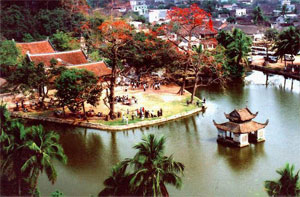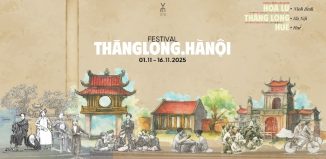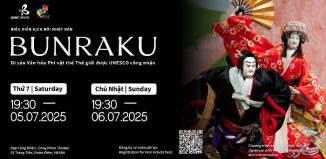Lễ Hội Chùa Thầy
Từ 18-22 tháng 4
Chùa Thầy ở phía tây Hà Nội, thuộc xã Sài Sơn huyện Quốc Oai
Khoảng thời gian cuối đời, nhà sư Từ Đạo Hạnh đã ngồi thiền trong vài tháng, không ăn, không uống trong suốt thời gian dài và đã nhập thiền.
Xem bài trước viết về chuyến thăm quan chùa Thầy trên Hanoi Grapevine.
Lễ hội chùa Thầy là lễ hội chung của 4 làng: Làng Thụy Khuê, Đa Phúc, Khánh Tân, và Sài Khê. Lễ hội được tổ chức tập trung ở khu vực xung quanh chùa bao gồm 3 tòa chính: chùa Hạ- nơi các tăng ni phật tử nghe giảng đạo, chùa Trung- là nơi thờ các vị Tam Bảo và chùa Thượng- là nơi thờ Thiền sư Từ Đạo Hạnh. Thiền sư Từ Đạo Hạnh được biết đến là người có công dẫn dắt đời sống tôn giáo và đã nhập thiền ở ngôi chùa này. Khoảng thời gian cuối đời, nhà sư Từ Đạo Hạnh đã ngồi thiền trong vài tháng, ông không ăn và không uống trong suốt thời gian đó và đã nhập thiền. Sau đó, thi hài chỉ còn là bộ xương của ông được người dân đặt trong ngôi chùa này và thờ cúng. Đời vua Minh- Trung Quốc xâm lược Việt Nam từ năm 1407 đến năm 1427 đã đem thi hài của Từ Đào Hạnh lên núi và chôn ở đó. Người dân địa phương đã thu lượm tro của ông và trộn với đất để làm thành tượng thờ ông. Người dân tin tưởng rằng ông có sức manh siêu nhiên và kết quả là ông đã trở thành thần và sau đó là trở thành Phật.
Lễ hội chùa Thầy diễn ra từ ngày mùng 5 đến ngày mùng 9 tháng 3 Âm lịch, năm nay là ngày 18-22 Tháng 4. Họ tổ chức lễ tắm tượng Phật Từ Đạo Hạnh, lễ dâng nhang, lễ rước kiệu, chương trình biểu diễn các vở kịch dân gian (Chèo- tìm hiểu thêm thông tin ở http://en.wikipedia.org/wiki/Cheo), chơi cờ, các buổi biểu diễn múa rối nước và nghe tường thuật về công lao của Thiền sư Từ Đạo Hạnh.
Lễ rước kiệu diễn ra vào ngày mùng 7 tháng 3 Âm lịch, năm nay là ngày 20 tháng 4 với sự tham gia của cả 4 làng. Phần mở màn của lễ rước, kiệu của ông được phủ một tấm vải màu vàng biểu tượng cho sức mạnh siêu nhiên của ông và khi lễ rước kết thúc kiệu đó phải được phủ bằng chiếc áo cà sa màu nâu của người tu hành.
Trong suốt lễ rước, nữ thầy tu vừa đi vừa giảng vê những công lao của Thiền sư Từ Đạo Hạnh, đẩu tiên là về sức mạnh siêu nhiên của ông và tiêp đến là thành công trong lĩnh vực dẫn dắt đời sống tôn giáo của ông. Lễ rước được tiến hành rất chậm rãi và thường quay trở về chùa vào lúc đêm. Thời điểm này được xem là thời điểm chuyển giao giữa đêm và ngày- thời điểm mà sự liên lạc giữa những con người với nhau bắt đầu. Thứ tự của lễ rước cũng thay đổi theo từng sự kiện cụ thể. Đi đầu lễ rước là kiệu của Thần Hoàng Làng và tiếp đó là Ngựa đỏ của làng Thụy Khê và làng Khánh Tân, phía sau cùng là kiệu của Từ Đạo Hành. Kiệu của Thần Hoàng Làng của làng nào thì người của làng đó rước, còn kiệu của Thiền sư Từ Đạo Hành được rước bởi 4 người được chọn ra từ 4 làng. Khi quay trở về, kiệu của Thần Hoàng Làng và Ngựa Trắng của làng Đa Phúc phải đi trước, theo sau là Thần Hoàng Làng và Ngựa Đỏ của làng Thụỵ Khê. Thứ tự này được duy trì cho đến hết lễ rước kiệu.
![]()
| Dịch sang tiếng Anh bởi cô giáo tiếng Việt của tôi, cô Bùi Phương Thảo. Tôi cần sự giúp đỡ của bạn: Nếu bạn biết gì về những sự kiện văn hóa của Việt Nam ở Hà Nội, hãy kể với tôi. Hanoi Grapevine giới thiệu chủ yếu về nghệ thuật đương đại và văn hóa đương thời của Việt Nam. Chúng tôi sẽ đưa thông tin về các sự kiện văn hóa trong chuỗi những sự kiện phong phú của di sản văn hóa Việt Nam. |
















Có một chùa nữa cũng trong hệ thống thờ Thiền sư Từ Đạo Hạnh là chùa Láng. Hội chùa Láng mở vào ngày 7.3 âm lịch. Chùa được xây dựng vào thế kỷ thứ 12 ngay trên nền nhà Phụ mẫu của Từ Đạo Hạnh (tại Láng Thượng, quận Đống Đa). Đây là hội lớn của các làng nằm bên sông Tô Lịch, tại ngôi chùa từng được coi là đệ nhất tùng lâm ở phía Tây kinh thành Thăng Long xưa.
Chùa Thầy ở Sơn Tây cũng thuộc hệ thống chùa thờ Từ Đạo Hạnh nên dân gian có câu rằng: “Nhớ ngày mồng bảy tháng ba,Trở về hội Láng, trở ra hội Thầy”.
Lưu ý là trong tiếng Việt, những người nữ xuất gia theo đạo Phật được gọi là ni cô (gọi chung), hoặc sư bà (người có tuổi, thường là trụ trì một chùa). Khi giao tiếp với họ, gọi họ là “cô”.
Quý Diệp_vi, bằt đầu tôi muốn xin lỗi tôi không nói tiếng Việt rất tốt. Thứ hai tôi muốn xin lỗi vì lâu rồi tôi không trả lơi. Cảm ơn quý Diệp_vi rất nhiều – tôi sẽ đi đến chùa Láng để xem quang chùa. Tôi cũng sẽ viết ngày hội chùa Láng và năm sau tôi sẽ đi đến đó xem hội.
Cũng cảm ơn quý Diệp_vi – tôi sẽ biết các người nữ xuất gia theo đạo Phật gọi là “cô”.
Roman